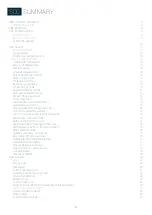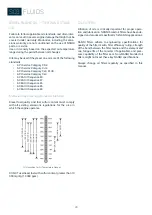
16
S02
SAFETY
SAFE COOLING SYSTEM SERVICE
Explosive release of fluids from pressurized
cooling system can cause serious burns.
Shut off engine. Only remove filler cap when
cool enough to touch with bare hands.
Slowly loosen cap to first stop to relieve
pressure before removing completely.
AVOID HEAT NEAR PRESSURIZED FLUID
LINES
Flammable spray can be generated by heating near
pressurized fluid lines, resulting in severe burns to
yourself and bystanders. Do not heat by welding,
soldering, or using a torch near pressurized fluid lines
or other flammable materials.
Pressurized lines can accidentally burst when heat
goes beyond the immediate flame area.
Any fluid injected into the skin must be surgically
removed within a few hours or gangrene may result.
Doctors unfamiliar with this type of injury should
reference a knowledgeable medical source.
WELDING NEAR ELECTRONIC CONTROL
UNIT (ECU)
If welding is required around the engine, or
in the engine room, ask first for a permission
from the person in charge. Do not jump-
start engine with arc welding equipment.
Currents and voltages delivered are too
high and may cause permanent damage.
Direct welding onto the engine is forbidden.
1.
Disconnect the negative (-) battery cable(s).
2.
Disconnect the positive (+) battery cable(s).
3.
Connect the positive and negative cables
together. Do not attach to engine support frame.
4. Clear or move any wiring harness sections
away from welding area.
5. Connect welder ground close to welding point
and away from control units.
6.
After welding, reverse Steps 1-5.
STATIC ELECTRICITY RISK
The removal of sulphur and other compounds in
Ultra-Low Sulphur Diesel (ULSD) fuel decreases its
conductivity and increases its ability to store a static
charge. Refineries may have treated the fuel with a
static dissipating additive.
However, there are many factors reducing the
effectiveness of the additive over time. Static charges
can build up in ULSD fuel while it is flowing through
fuel delivery systems. Static electricity discharge in
presence combustible vapours could result in a fire or
explosion.
Therefore, it is important to ensure that the entire
system used to refuel your engine (fuel supply tank,
transfer pump, transfer hose, nozzle, and others) is
properly grounded and bonded.
Consult your fuel or fuel system supplier to ensure
that the delivery system is in compliance with fuelling
standards for proper grounding and bonding practices.
HANDLE FUEL SAFELY - AVOID FIRES
Handle fuel with care: it is highly flammable. Do not
refuel the engine while smoking or when near open
flame or sparks. Always stop engine before refuelling.
Prevent fires by keeping engine room clean of
accumulated trash, grease, and debris. Always clean
up spilled fuel. Use only an approved fuel container for
transporting flammable liquids.
Do not store fuel container where there is an open
flame, spark, or pilot light such as within a water heater
or other appliance.
BE PREPARED FOR EMERGENCIES
Be prepared if a fire starts. Keep a first aid kit and
fire extinguisher handy. Keep emergency numbers
for doctors, ambulance service, hospital, and fire
department near your telephone.
Содержание Q1500 Series
Страница 1: ...NANNI GENERATOR SET USER MANUAL DGBXXT090049 Q1500 Series...
Страница 2: ......
Страница 4: ...4 Q00 TRACKED CHANGES...
Страница 8: ...8 S00 SUMMARY...
Страница 32: ...32 S03 FLUIDS...
Страница 38: ...30 S05 COMPOSANTS...
Страница 40: ...32 S05 COMPOSANTS VIEW N 1 OF THE GENERATOR SET...
Страница 41: ...33 S05 COMPOSANTS VIEW N 2 OF THE GENERATOR SET...
Страница 52: ...52 S 07 MAINTENANCE Battery voltage 72 Battery specific gravity 72...
Страница 53: ...53 S 07 MAINTENANCE...
Страница 74: ...74 S 07 MAINTENANCE...
Страница 76: ...76 S08 AL TERNATOR...
Страница 88: ......
Страница 96: ...96 S11 TROUBLE SHOOTING...
Страница 97: ......
Страница 98: ......
















































